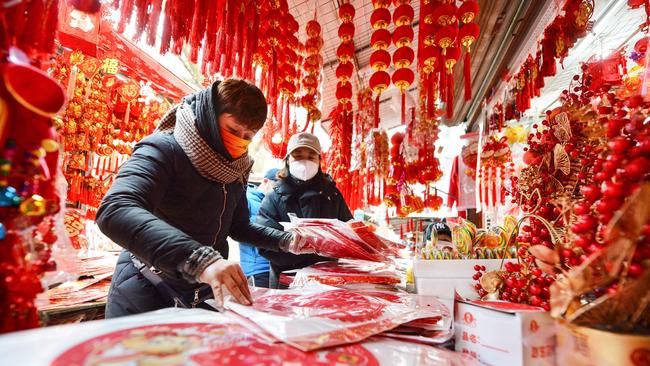
China officials announced this week that after January 8 approved inbound travellers who have a negative Covid test before departure can visit the country with no quarantine period and that restrictions on airline travel would be gradually eased.
China will make it easier for foreign nationals to visit the country for work, business, education and visiting relatives.
The government also plans to “resume outbound tourism for Chinese citizens in an orderly fashion, starting with a pilot scheme”, according to the Ministry of Foreign Affairs.
In the short term, China will have to go through what could be a horror period where vast swathes of its population go through a Covid wave.
The annual Chinese New Year migration – this time from January 22 – could see another wave of the virus spread to rural areas.
For China, 2023 is most likely to be one of two halves: a slow opening up in the first half and a more globally engaged second half. Economic activity is expected to follow a similar pattern.
Fear of Covid will see foreigners and Chinese living overseas wanting to reunite with family and friends being wary about plans for a visit to China while they assess the situation.
Australian business leaders looking at going to China have indicated that they will wait at least until after the annual “two sessions” in March. Others say foreign business visitors may hold off until May.

For their part, the Chinese population is eager to re-engage with the rest of the world, prompting an upsurge in outbound tourism when it is allowed.
Chinese citizens have been scanning sites such as those run by Ctrip, with the travel company reporting strong interest in travel to the region, including Hong Kong, Macau, Singapore, South Korea, Japan and Thailand.
Chinese social media this week was abuzz with people planning their offshore travel for the second half of 2023.
Japan and India have already reacted to the expected upsurge of travellers with requirements on travellers from China to have Covid tests.
The return of Chinese travellers to the global scene will be one facet of Chinese engagement in 2023. Before Covid in 2019, more than 155 million Chinese travelled overseas – of which more than 1.4 million came to Australia. By 2020 only 20 million Chinese travelled offshore, a figure which fell to only 8.5 million in 2021.
But as China reopens, global businesses are also thinking about how they re-engage.
The sheer size and strength of the Chinese market has always been an attraction for global business – one which could be even more attractive as the Western world heads for much slower growth in 2023 as China potentially rebounds.
The rapid move to a reopening of the Chinese economy in the past few weeks – just when it seemed as if Covid lockdowns would persist into 2023 – has seen many economists upgrade their outlook for next year.
This month economists at the National Australia Bank cut their expectations of China’s economic growth for this year, from 3.4 per cent to 3.1 per cent on concerns about the impact of Covid-19, but boost their predictions for 2023 from 5 to 5.2 per cent.
The Economist Intelligence Unit has upgraded its outlook for Chinese growth from 4.7 to 5.2 per cent in 2023, and up from 4.5 to 4.8 per cent in 2024.

The EIU is predicting 2023 will be “characterised by a weaker first six months and a strong second half. After a difficult first quarter, China’s economic momentum will probably build in the second quarter before a strong recovery sets in during the second half of the year,” it says.
Morgan Stanley raised its expected outlook for the economy from 5 to 5.4 per cent, with other US investment banks also upgrading their forecasts.
The Chinese economy provides access to a huge consumer market which is attractive to global businesses in a period of low growth in the rest of the world.
On the other hand, the past few years have solidified the view among global companies of the need to diversify supply chains away from China – despite the cost advantages that “Made in China” can bring.
Global companies like Apple and Taiwanese manufacturing giant Foxconn are expanding their manufacturing footprint outside of China for products such as iPhones and MacBooks.
Counterpoint Research has suggested that Foxconn could move as much as 30 per cent of its global manufacturing capacity to countries outside of China including India and Vietnam.
Add to this the development of a global tech divide which was started by the Trump administration and has been continued by the Biden administration. While his rhetoric on China is more moderate than his predecessor’s, President Biden has sought to press hard on China’s vulnerability in semiconductors, ordering US companies not to supply high-end chips to China and pressing others to do the same.
The ban is already hitting China’s electronic giant Huawei, once seen as a global leader in smart phones.
The US move on chips as well as its policies on rare earths are laying down lines in the sand which are also flowing through to allies such as Australia, encouraging the development of China and non-China supply fault lines for certain sectors.
As Australia has seen, China is stepping back from its aggressive wolf warrior diplomacy. But the world of 2023 is much more fractured, more prepared to look at some decoupling from China – even if it comes at a higher price – and is still wary of Chinese policy on Taiwan, the South China Sea and Hong Kong and its apparent closeness with Putin’s Russia.
This will be a year when China re-engages with the rest of the world but the game has changed.
The world is watching to see how much President Xi really does want to engage with the rest of the world but has also spent the past three years looking at other paths as well.








As the world’s second largest economy begins to open up – officially from January 8 – the question is: What sort of engagement China will have with the rest of the world in 2023 after three years of shutdown?